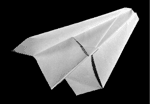|
|||||||||
|
|
||||||||||

|
||||||||||
|
If you've ever made a paper
airplane, you've probably just folded the paper into a simple dart—as
people have done for at least a hundred years. But in the last two decades,
paper airplane designers have imported techniques from origami. Perhaps
the best innovation was the addition of one fold to the classic dart
design to create a plane called the "Nakamura lock" after
the origami artist who designed it.
|
||||||||||
|
||||||||||
|
Once you've made all of your folds and the plane looks symmetrical, it's time to trim it, or adjust it, for flight. Give it a gentle toss forward. Your goal is to have it glide smoothly and gently to the ground, either flying straight or in a gradual curve.
Make these adjustments, if
necessary:
When you get the plane to balance on the air and float down gently, then you can give it faster tosses. |
||||||||||
|
Now that you have a flying plane, you can use it to see the roles that paper plays in its construction. After the kinetic energy (that is, the energy you put into it by throwing it) of the initial throw has dissipated, paper planes are gliders powered by gravity. As the plane falls, its wings deflect air backward and down, providing thrust and lift. Paper makes a good wing because it's impermeable to air: In a single sheet of paper, multiple layers of interlocked fibers prevent air from flowing through. In contrast, a hole-filled screen from a back door would not make a very good wing.
|
||||||||||

|
|

|
|

|
| © Exploratorium |







